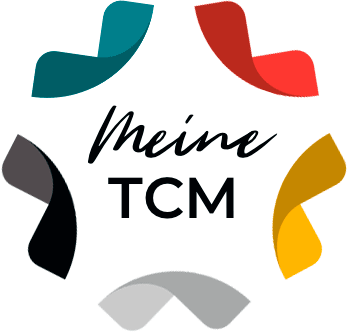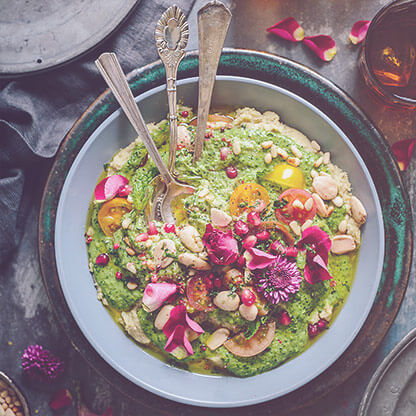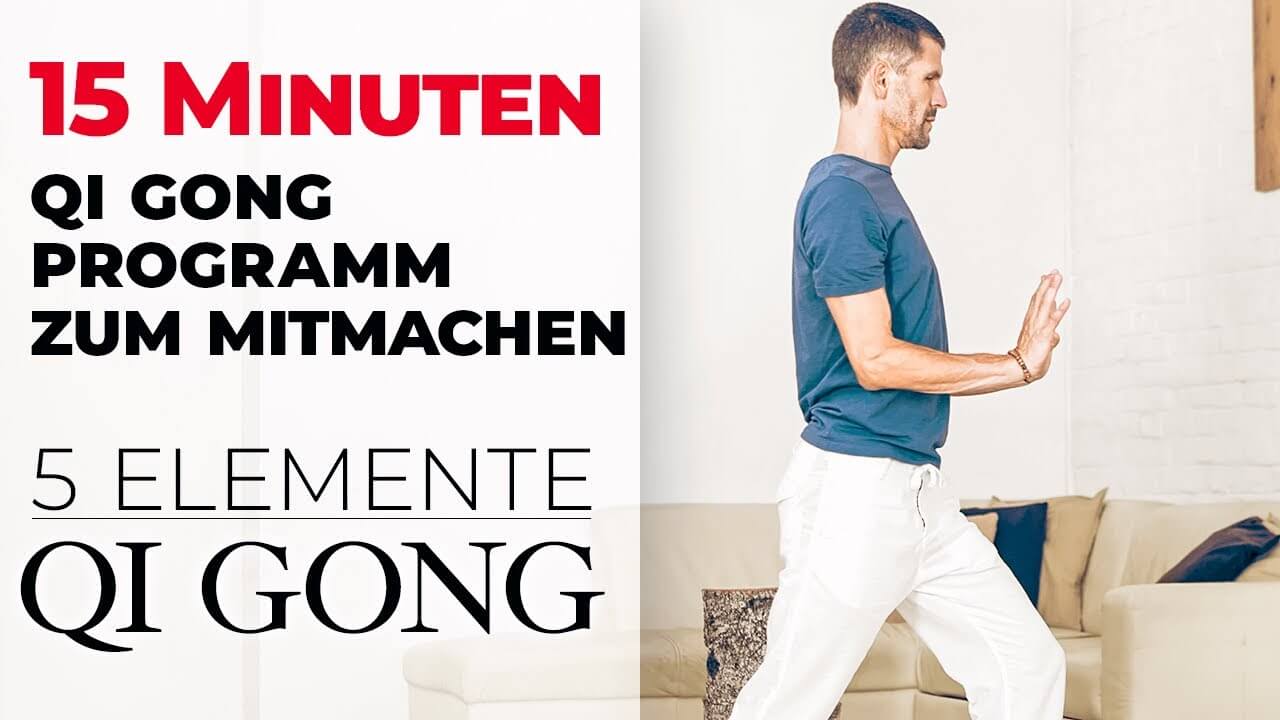Headache in the forehead area
... Acupuncture points against forehead headache

Wolfgang's herbs tips
Application:
Pain in the upper abdomen, headaches, dizziness, dry throat, irregular menstruation, breast tenderness during menstruation, tiredness, reduced appetite, weather sensitivity (wind!) with headaches and tiredness, cyclical malaise, stress dependency, irregular digestion, depression, exhaustion, burnout.
240 tablets

Wolfgang's Qi Gong Tips
If you do Qi Gong for preventive reasons, it is quite possible to achieve good results with 15 minutes of daily practice. If you have a complaint, it is recommended to practice 2 times 15 minutes daily or 30 minutes at a time daily.
Basically, it is better to do 6 times 15 minutes Qi Gong, than once 1.5 hours. Therefore, I show you here a short variant of the 5 elements Qi Gong.


With the Training calendar you learn the exercises step by step. 15 workouts provide for variety.
This Meridian yoga exercises are also available for Beginners easy to learn.

TCM background information

PaM-3 "Seal Hall" - Yintang
Master point for headaches and stuffy nose
- Location:
In the middle between the eyebrows, at the root of the nose, at its deepest point.
- Helps with:
Eye diseases, nasal congestion, insomnia, headache (especially in the forehead area), dizziness, sinusitis,
Comment:
This point is called the master point for headache and nose. Together with Bl 02 it has an even stronger effect. But it also has a strong mental calming effect.
This point is also called the upper dantien. Dantien means as much as "Sea of Energy. The lower dantien is the KG 6 point, the middle dantien is the CV 17 point and the upper one is the PaM-3 point.
PaM means: point outside the meridians. These are points that are very effective from the millennia-old tradition, but just do not lie on any of the classical meridians.
There are a total of 48 such extra points, as they are also called.
Bl 02 "Folded bamboo" - Zanzhu
Important local point of influence for the eyes
- Location:
At the inner end of the eyebrow
- Helps with:
Forehead headache, stuffy nose, defective vision, eye redness, eye problems, hay fever.
Comment:
This is an important local point for the eyes. It expels external wind from the face. Therefore, it is helpful in facial stics, fascial paresis and trigenimus neuralgia.
Since Bl02 also soothes the liver, it can be used for all liver patterns: red eyes, blurred vision, mouches volantes and headaches around the eyes or behind the eyes.
Tue 4 "United Valleys" - Hegu
Master point for pain in the head and face, especially for acne
- Location:
In the middle of the 2nd metacarpal on the radial side in a depression.
- Helps with:
Pain especially in the head area, neck pain, stiff neck, headaches, colds, flu-like infection, sore throat, cough, migraine, stuffy nose, dizziness, hay fever, soothing effect for all intestinal complaints, distant point for arm and shoulder pain.
Comment:
This item is included in the Pregnancy prohibited, as it is used to speed up the birth process.
It is often used as a remote point in the treatment of facial, oral, nasal and eye problems.
The combination LI 04 with Lv 03 is called "4 gates" and is very well known, because it is Wind from the head area dispels pain and calms the mind.
Di 04 also has a strong relation to the psyche and can therefore be needled to calm the mind and anxiety. In this case, the combination Di04 +Le03+LG24 is used.
Combine Di04 with another very important item, Ma36, and you have a brilliant combination to strengthen the immune system.
Gb 14 "Yang-white" - Yangbai
Important point for headache and sinus problems
- Location:
1 cun above the middle of the eyebrow
- Helps with:
Headache, fascial paresis, sinus problems, burning eyes, twitching of the eyelid, defective vision, night blindness
Comment:
This point acts as a Local Point for headaches when they are in the course of the gallbladder meridian, that is, on the side of the temples. But it is also effective for unilateral forehead headache.
St 36 "Three miles of the foot" - Zusanli
Most important point of the stomach meridian to strengthen digestion
- Location:
4 transverse fingers (3 cun) below the lower edge of the patella (knee cap) on the tibialis muscle
- Helps with:
indigestion, bloating, constipation, stomach pain, fatigue, headache, loss of appetite, blurred vision
Comment:
This point is a prominent point in TCM because it strengthens the post-heaven qi. What is meant by this is that it strengthens the stomach and spleen, those organs that are responsible for our energy intake through food.
Ma36 is a general toning point for the whole body, but also for the psyche, and is used for all symptoms of fatigue, tiredness and weakness.
Together with MP06, Le03 and Di04, it is one of the most famous and frequently used points in Chinese medicine.
St 44 "Inner Court" - Neiting
Important point on the stomach meridian that eliminates heat
- Location:
The acupuncture point is located in the webbed skin between the 2nd and 3rd toes.
- Helps with:
Headache, bloating, bleeding gums, fascial paresis
Comment:
This point acts as a distant point for headaches when they are in the forehead area.
Lv 03 "Big meeting" - Taichong
Source Point of the liver meridian, most important point on the liver meridian
- Location:
on the dorsum of the foot between the 1st and 2nd toes, at the end of the "groove".
- Helps with:
Migraine with sensitivity to light, menstrual problems, nausea, abdominal pain, general tension relieving, constipation.
Comment:
This is an important point to eliminate Fullness in the liver, it is somewhat milder in effect than Le02.
It has a special effect on cramps and increased muscle contraction.
It has a profound and calming effect on the psyche and is an important point for very tense, impatient and stressed people. This function is lacking in the point Le 02. For this purpose, the point is often used together with Di4. Together they belong to the most important acupuncture points and are called the "Four Gates".

The word Qi Gong consists of 2 syllables - Qi and Gong. The Chinese term "Qi" can be translated for us most likely by "life energy". But it contains more than this. It also means breath and air. In Chinese medicine, Qi is considered to be the invigorating force that flows through all living things. However, Qi is not only inside the body of a living being, but also outside. Qi also shows itself to us in nature. Thus animals, flowers and trees are flowed through by Qi. Qi is the living force that is inherent in everything and that makes life possible.
The Japanese call this force "Ki". In India it is called "Prana". It always means the same thing - the power and energy that is inherent in everything and keeps us alive. In Chinese medicine, health is only possible when the Qi in our body is pure, not polluted and can flow freely.
Due to bad living habits, in the course of time, energy blockages can occur in the body system and as a result, diseases can manifest, which can be physical or psychological in nature. Generally speaking, we can say that a living person has Qi throughout the body.
The word "gong means roughly "body work" or "success through perseverance and practice". Therefore Qi Gong is called "Work with the life energy". We learn to improve the flow and distribution of Qi in our body through movement and concentration to strengthen our health and bring body and mind into harmony. At the same time we learn to stand correctly, between heaven and earth. This significantly improves posture and many aches and pains disappear on their own.
Qi Gong is a holistic healing system with a long tradition, which has been continuously developed until today. It includes health-promoting postures, movement, self-massage, breathing techniques and meditation. Through these various exercise methods, Qi is supposed to be collected and stored in the body, like in a reservoir. The goal is to expel the impure Qi and absorb fresh pure Qi.
Qi Gong is not a medicine that is prescribed for a limited time, but rather it should be practiced daily. In this regard, 20 minutes of daily practice is enough to improve health and one's well-being to a great extent.
Anyone can practice qigong. There are exercises for every age and every state of health. The exercises can be practiced standing, sitting, lying down or walking. So even physically challenged people can easily practice Qi Gong and improve your health in a sustainable way.
You are interested in this topic?
Then you can find even more information about it here.
You want to learn Qi Gong - easily from home?
With our modern Qi Gong online courses this is easily possible!

The herbal therapy is called "the queen of TCM" in traditional Chinese medicine. This underlines its high status. Herbs form an important foundation of TCM and have a profound effect on the human organism. They can replenish deficiencies, expel states of fullness, warm or cool the body. They are generally referred to as herbs. Nevertheless, minerals are also used in the recipes.
Herbs are usually prescribed after a thorough diagnosis by a doctor. In this diagnosis, in addition to a conversation, attention is paid to the pulse, tongue and overall appearance of the person. Nevertheless, there are herbal mixtures that have proven themselves over the centuries for various problems.
We have made suggestions for all clinical pictures for such proven recipes. Nevertheless, in many cases it may be necessary to consult a doctor or therapist. Based on the individual situation, this person can recognize how the energetic situation really is at the moment and, based on this, recommend the optimal herbal mixture. Of course we do not have this possibility, because we cannot meet you personally. Nevertheless, if you have any questions, please feel free to contact us and we will try to help you as much as possible.
For many disease patterns there are 2-3 herbal suggestions. The first suggestion is always the one that from my experience is suitable for most people. However, if there is no reaction, then try the second mixture that is suggested to you.
However, herbal therapy needs some patience, because in most cases it works slowly and subtly. In return, there are no side effects and the effect is very long-lasting.
If you want to learn more about herbal therapy then just look at
Chinese herbs to.












